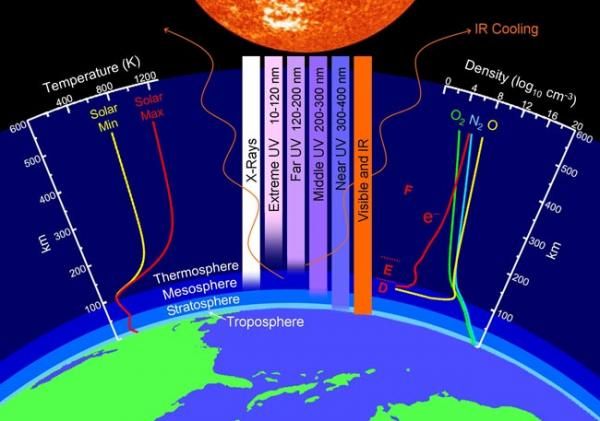
Record Collapse of Earth's Upper Atmosphere Puzzles Scientists

An upper layer of Earth's atmosphere recently collapsed in an unexpectedly large contraction, the sheer size of which has scientists scratching their heads, NASA announced Thursday.
The layer of gas called the thermosphere is now rebounding again. This type of collapse is not rare, but its magnitude shocked scientists.
"This is the biggest contraction of the thermosphere in at least 43 years," said John Emmert of the Naval Research Lab, lead author of a paper announcing the finding in the June 19 issue of the journal Geophysical Research Letters. "It's a Space Age record."
The collapse occurred during a period of relative solar inactivity called a solar minimum from 2008 to 2009. These minimums are known to cool and contract the thermosphere, however, the recent collapse was two to three times greater than low solar activity could explain.
"Something is going on that we do not understand," Emmert said.
The thermosphere lies high above the Earth's surface, close to where our planet meets the edge of space. It ranges in altitude from 55 miles (90 km) to 370 miles (600 km) above the ground. At this height, satellites and meteors fly and auroras shine. [Graphic: Earth's Atmosphere Top to Bottom ]
The thermosphere interacts strongly with the sun, so is very affected by periods of high or low solar activity. This layer intercepts extreme ultraviolet light (EUV) from the sun before it can reach the ground.
Sign up for the Live Science daily newsletter now
Get the world’s most fascinating discoveries delivered straight to your inbox.
When solar activity is high, solar EUV warms the thermosphere, causing it to puff up like a marshmallow held over a camp fire. When solar activity is low, the opposite occurs.
Recently, solar activity has been at an extreme low. In 2008 and 2009, sunspots were scarce, solar flares almost non-existent, and solar EUV radiation was at a low ebb.
Still, the thermospheric collapse of 2008-2009 was not only bigger than any previous collapse, it was also bigger than the sun's activity alone could explain.
To calculate the collapse, Emmert analyzed the decay rates of more than 5,000 satellites orbiting above Earth between 1967 and 2010. This provided a space-time sampling of thermospheric density, temperature, and pressure covering almost the entire Space Age.
Emmert suggests carbon dioxide (CO2) in the thermosphere might play a role in explaining the atmospheric collapse.
This gas acts as a coolant, shedding heat via infrared radiation. It is widely-known that CO2 levels have been increasing in Earth's atmosphere. Extra CO2 in the thermosphere could have magnified the cooling action of solar minimum.
"But the numbers don't quite add up," Emmert said. "Even when we take CO2 into account using our best understanding of how it operates as a coolant, we cannot fully explain the thermosphere's collapse."
The researchers hope further monitoring of the upper atmosphere will help them get to the bottom of the situation.
This article was provided by SPACE.com, a sister site to OurAmazingPlanet.












